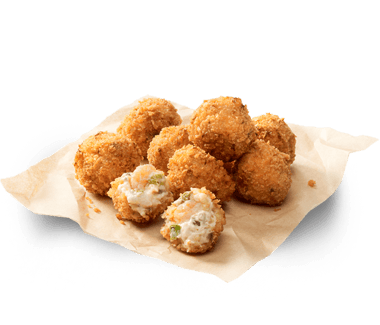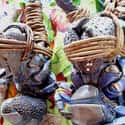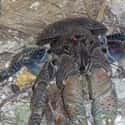-
(#11) They Have A Strange Relationship With The Sea
Unlike most crabs, this giant creature has adapted so well to life on land, it will drowned if left too long in water. Although it has modified gills surrounded by spongy tissue that must be kept moist, it achieves this through dipping its legs in the sea and sprinkling itself. It may drink some sea water to maintain its salt balance and of course, the females return to the ocean when they release their fertilized eggs.
The resulting larvae are planktonic for about a month - drifting freely around with other tiny organisms - until they settle on the sea floor and find their first gastropod shell.
-
(#3) They Can Eat Cats, Chickens, Birds, And Sometimes They Auto-Cannibalize
Despite its intimidating size, the robber crab is more of an opportunist than a predator. While it has been known to eat more sizable delicacies like chickens, kittens, and carrion birds, it tends to scavenge only what has been left behind. In 2017, people caught the coconut crab attacking a live bird for the first time.
The coconut crab is also one of the few creatures who self-cannibalize by eating others like themselves as well as their very own exoskeleton once it is sloughed off in the molting process. Experts believe this practice provides a great deal of calcium for creatures' astounding growth.
They also believe the coconut crab has only recently, through the evolutionary process, developed the ability to crack coconuts, a practice which allows them to eat less of their own kind.
-
(#10) They Could Become Endangered
Despite their curious appearance and behavior, not a great deal is known about the coconut crab or whether they are in danger of become extinct. While there's no doubt they are tough critters with an incredible ability to adapt, they may be vulnerable to the biggest predator of all - humans. Even though their overall habitat is relatively small, their total population has yet to be calculated by researchers, who have categorized them as "Data Deficient," meaning they are still trying to determine their population's status.
Some conservation efforts have implemented strategies to protect them from humans by limiting the number of crabs taken by hunters and enforcing a strict licensing process.
-
(#9) They Are Grouchy
Coconut crabs do not enjoy visitors. They are known to burrow deep into the cool sand beneath the roots of trees as a way to hide from the sun, and will even avoid crabs of their own kind. They will aggressively defend their territory if challenged - especially if there's any food involved. When they emerge, their temperament is not much better, and they are largely keep their distance from one another.
To announce their presence, they will wave their large claws around in warning and scuttle around any other crabs they see. Decidedly unsocial creatures (unless it's mating season), coconut crabs live solitary lives - and like it just fine that way.
-
(#6) They Can Break Into Coconuts With Their Claws
These great omnivores enjoy many different foods, although they number favorite is, of course, coconuts. Despite the notoriously tough outer shell, these tenacious crabs begin by tearing the husk, fiber by fiber, until it the hairy outside is completely removed. This can take several hours or even days. The task was so arduous researchers once believed it likely wasn't even possible for the crab to do it at all until they witnessed it first-hand.
They use their hammer-strong claws to dig into one of the "eye holes" until there is an opening, and suck out the liquid before cracking the whole thing open to eat the tender, white meat inside, which makes up the majority of their diet. Their great size has been attributed to this plentiful food source, although the crabs also feed on a variety of other protein-rich items.
They use their extremely well-developed sense of smell to find all sorts of beach goodies and will eat basically any organic matter they come across, or at least ferry it away for heavier inspection. The crab is typically a nocturnal eater, grabbing rotted fruit, pith from fallen trees, and any other morsels are often discovered under the cover of darkness.
-
(#13) They Fall From Trees
One of the most curious things about the coconut crab is its ability to crack open coconuts through climbing trees. Once the husk is removed, the crab can grip the remaining nut in its claws and climb a tree up to 33 feet high, dropping it from the top so it will crack on the ground below. This makes it easier to access the nutty deliciousness inside without too much labor. Climbing down is not quite as easy, however, and they often choose to free fall if the drop is not more than about 15 feet.
For those who find the coconut crab to be somewhat alarming, this reality can cause a paralyzing fear of walking through a tropical coconut grove where these crabs are known to live.
New Random Displays Display All By Ranking
About This Tool
As we all know, the coconut crab is the largest terrestrial arthropod and terrestrial crab. But you must not be fooled by its title. In fact, the natural habitat of coconut crabs is often in tropical woods not far from the sea, and the larvae produced by the breeding pair need to grow in the sea environment. Therefore, the Western Pacific and the entire Indian Ocean are their most common places of residence.
The coconut crabs are huge and anti-social, they will steal your silverware and can tear the whole coconut with their claws. It is a great time to know more about this shocking animal, the random tool introduced 13 facts about the coconut crab that many people do not know.
Our data comes from Ranker, If you want to participate in the ranking of items displayed on this page, please click here.
















